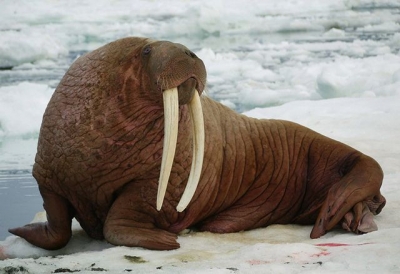
Walruses, often found lying on the ice in the Arctic Circle, are massive marine mammals. Their distinctive features are their long, white tusks. The tusks are actually their upper canine teeth that grow all through their lives. Both males and females have tusks which they use to break through ice and haul their huge bodies out of frigid waters.
Both sexes possess long tusks (the upper canine teeth) that project downward from the mouth. In the male they can grow to about a metre in length and 5.4 kg (12 pounds) in weight. The tusks function mainly in mating display and in defense against other walrus. They are not used to dig food from the ocean floor. The walrus feeds at depths of less than 80 metres (260 feet), usually at 10–50 metres (30–160 feet). Rooting along the ocean floor with its snout, it identifies prey with its whiskers. The walrus’s diet consists largely of clams and mussels but occasionally includes fish and even small seals.
The walrus is valued by both the Inuit and commercial hunters for blubber, hide, and ivory tusks. Its numbers have been reduced by commercial operations. Walrus are now protected from sealers but are still subject to subsistence hunting by aboriginals. Like seals, the walrus is a pinniped. It is the sole living member of the family Odobenidae.
Credit : Britannica
Picture Credit : Google



